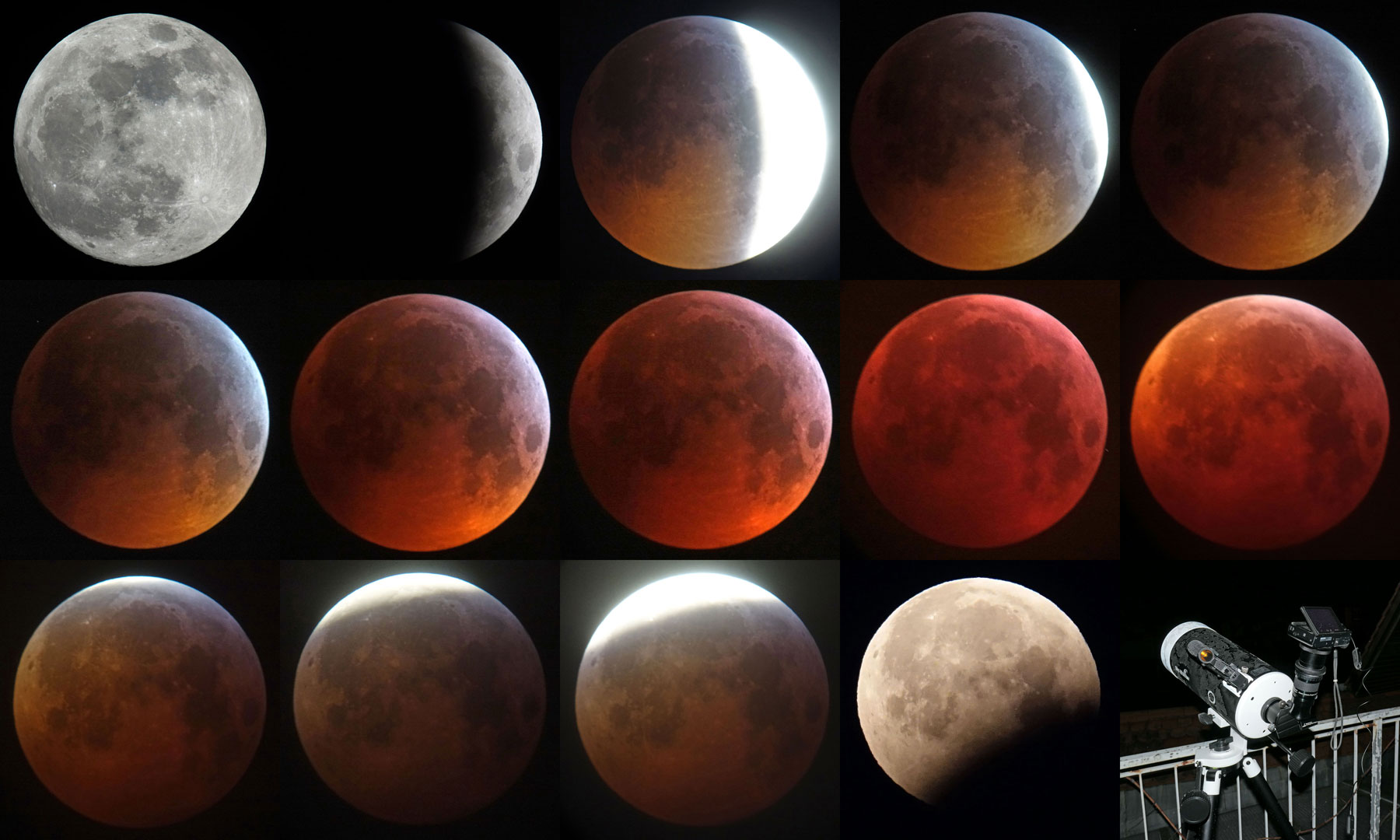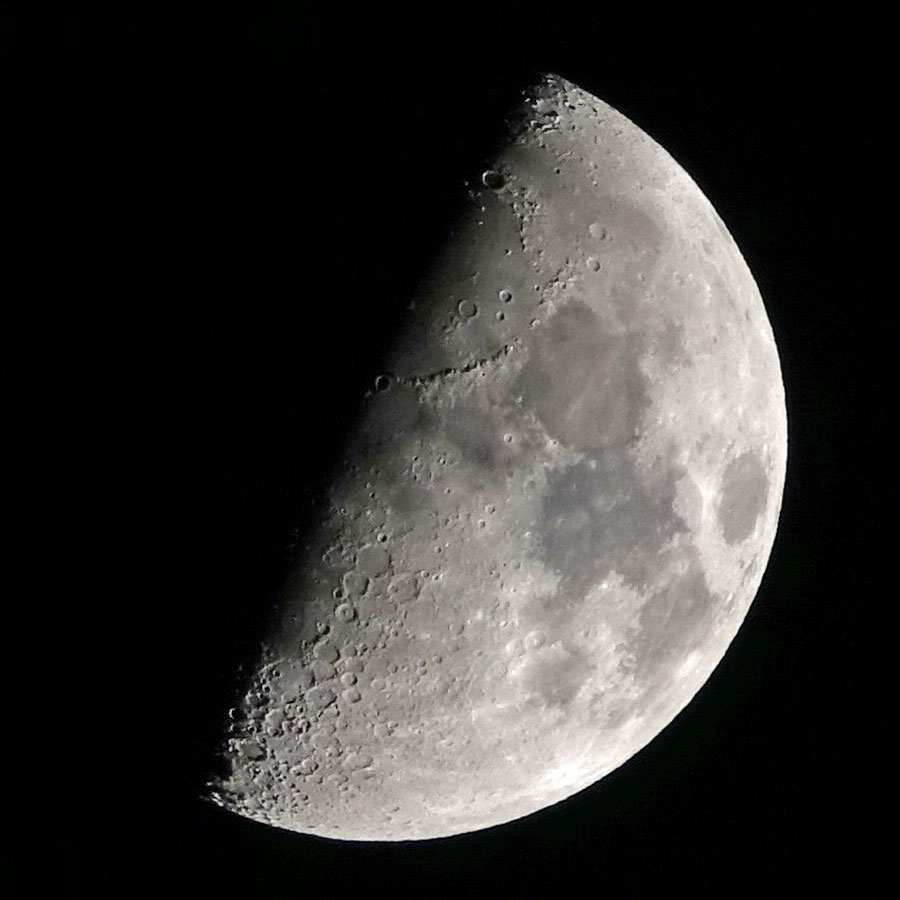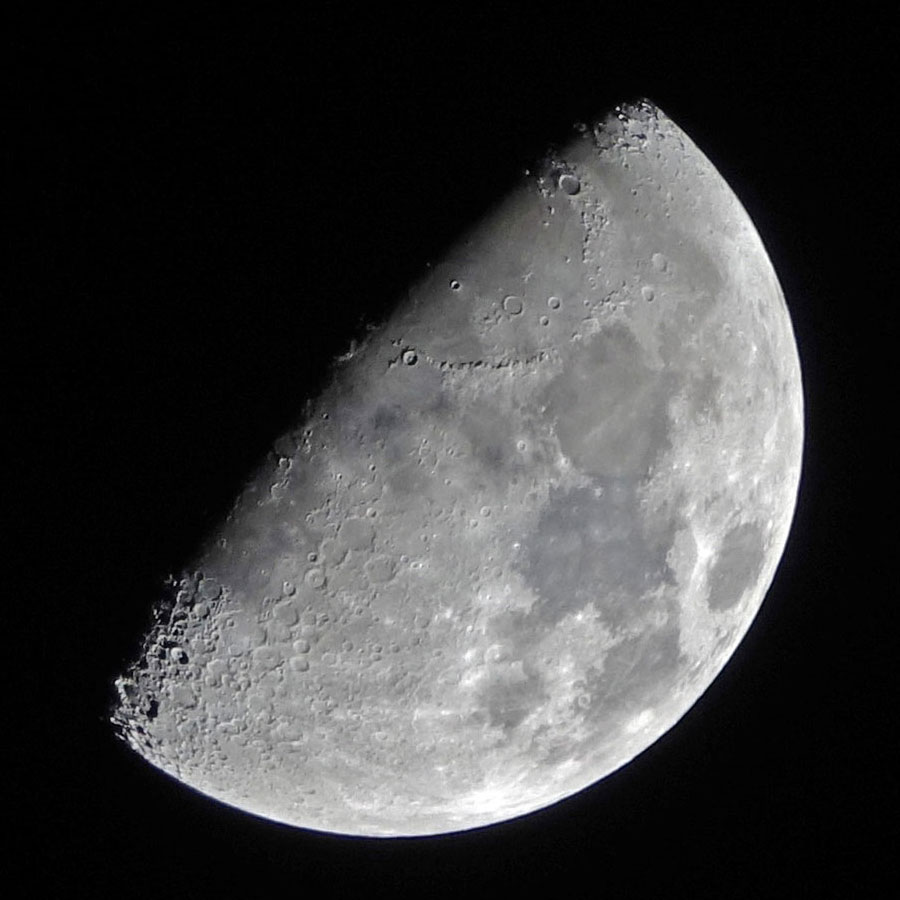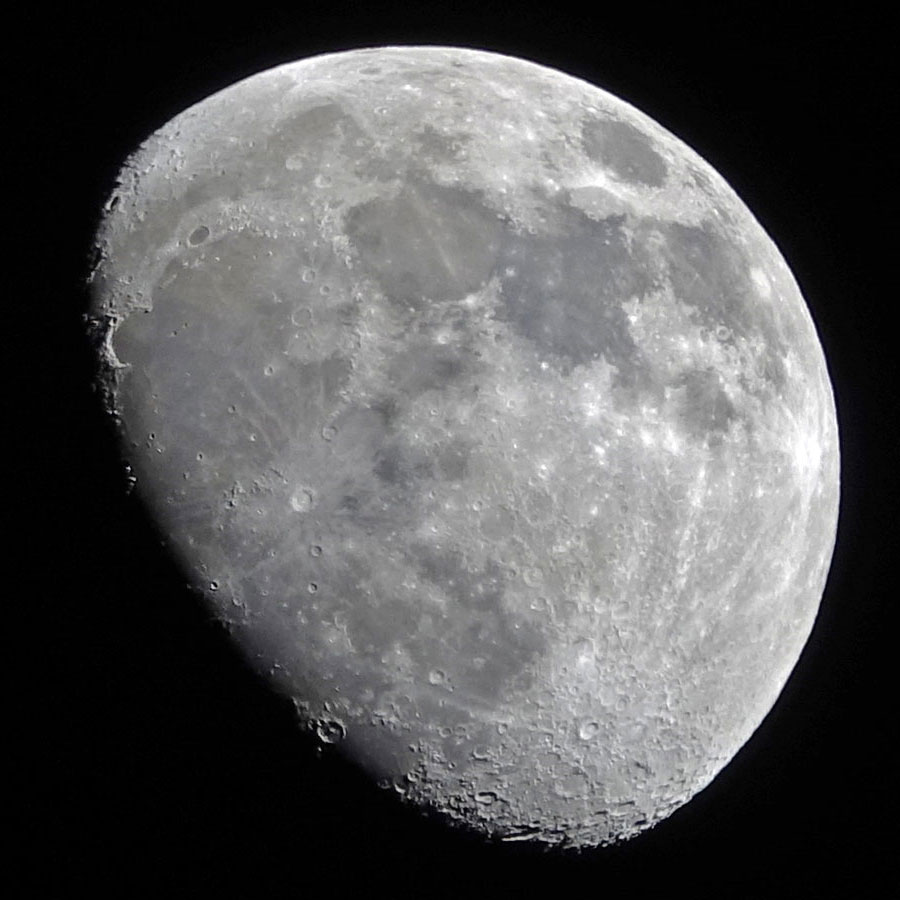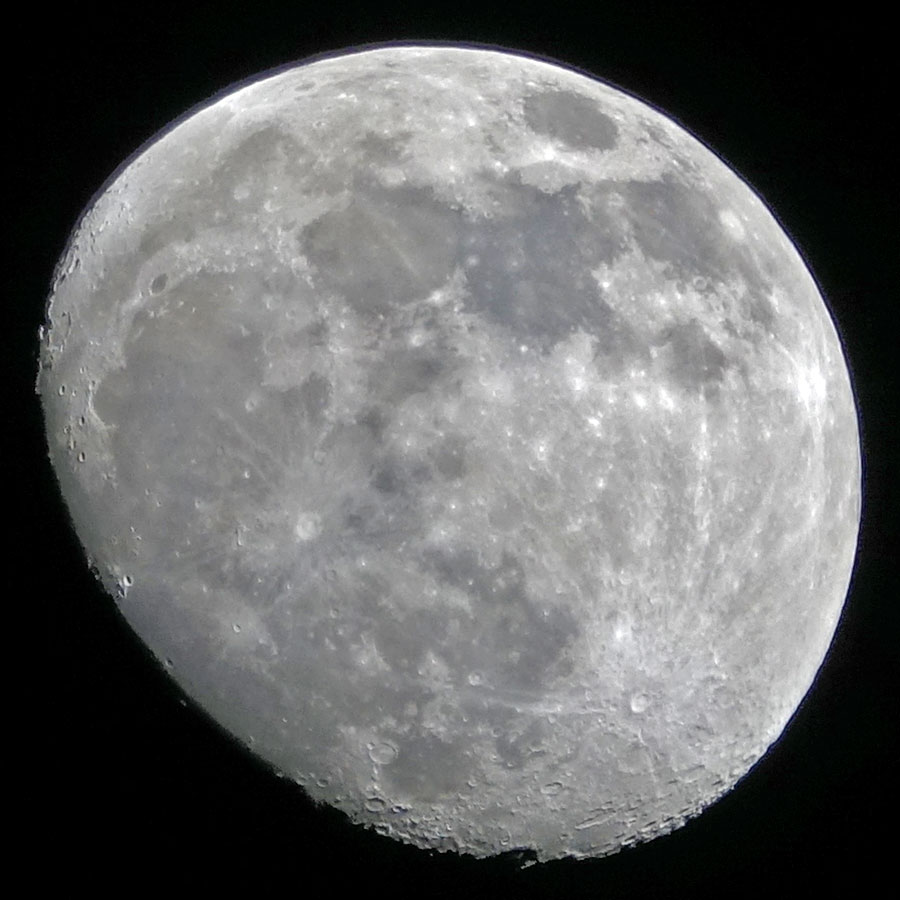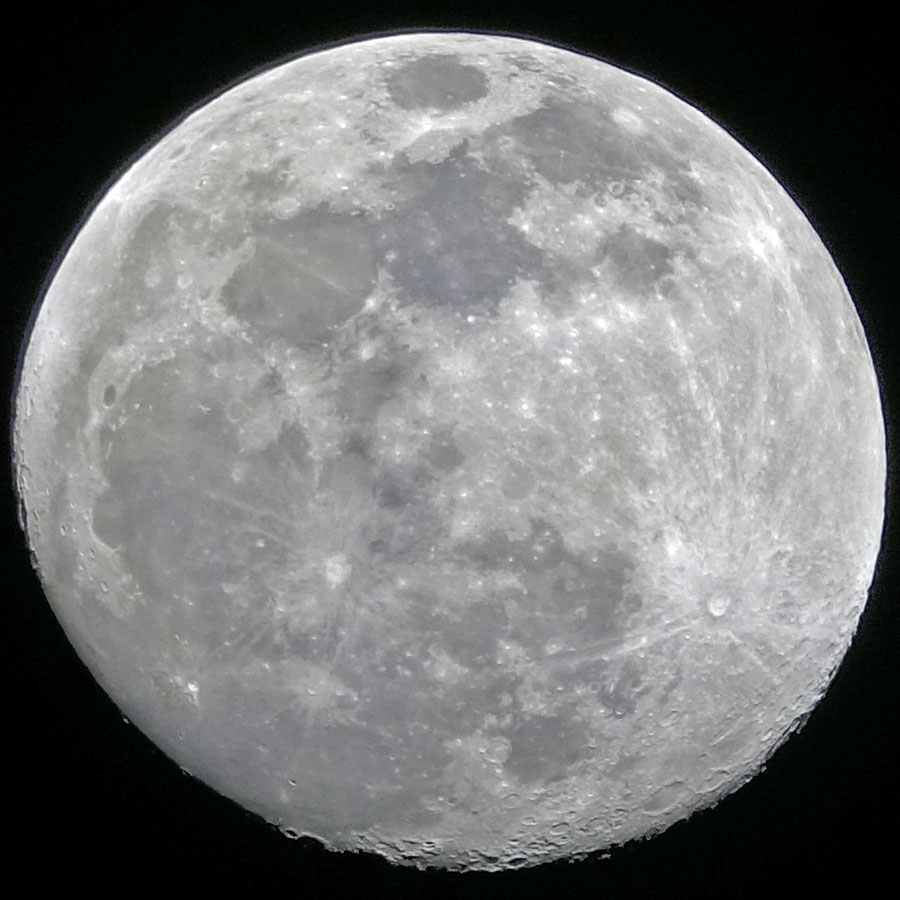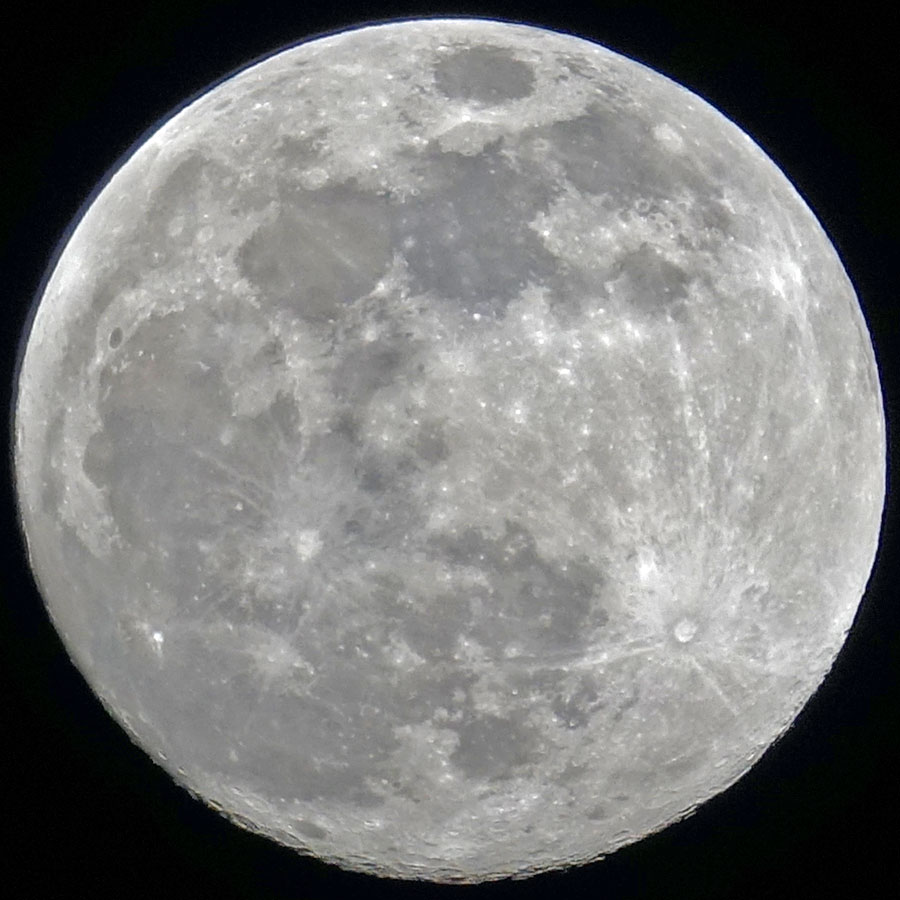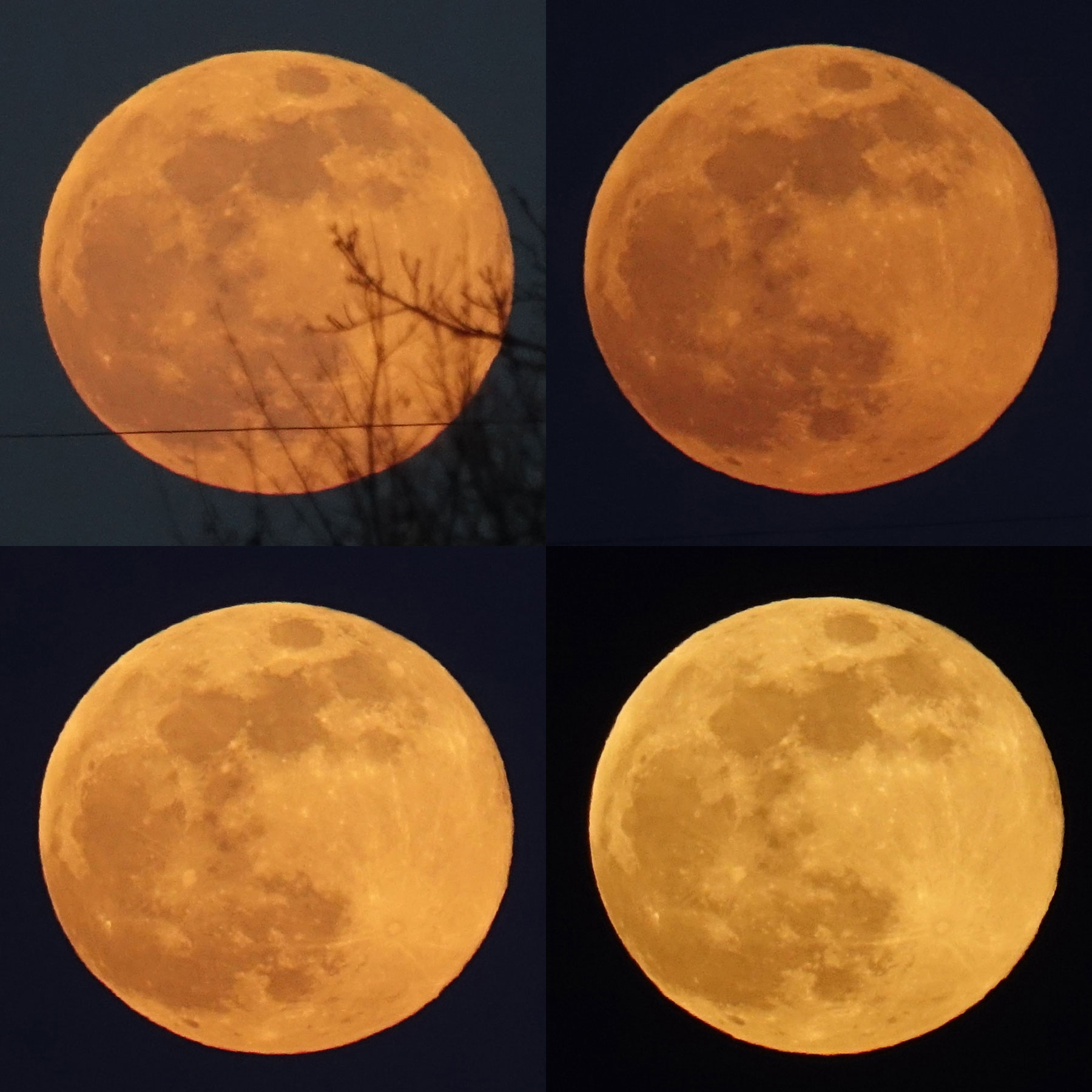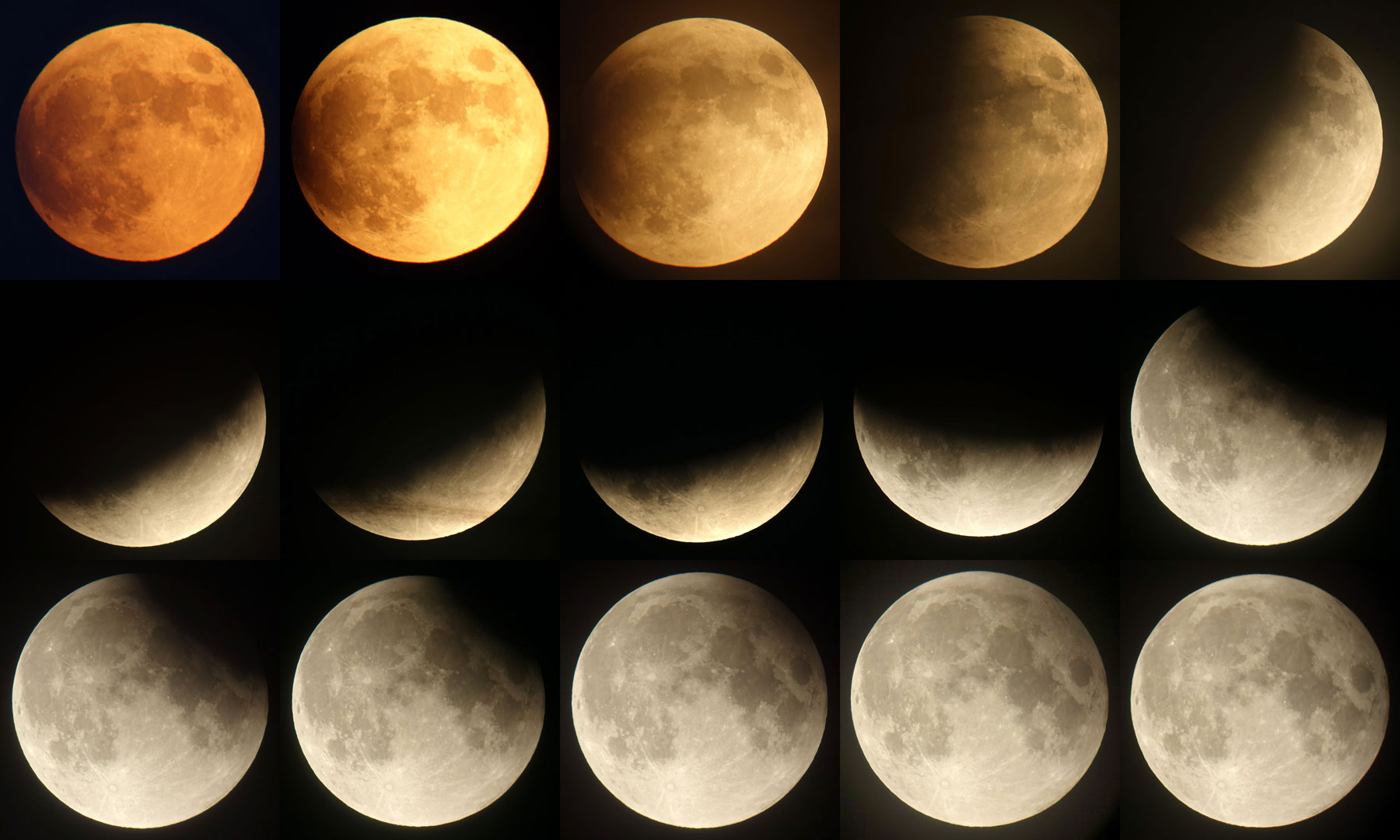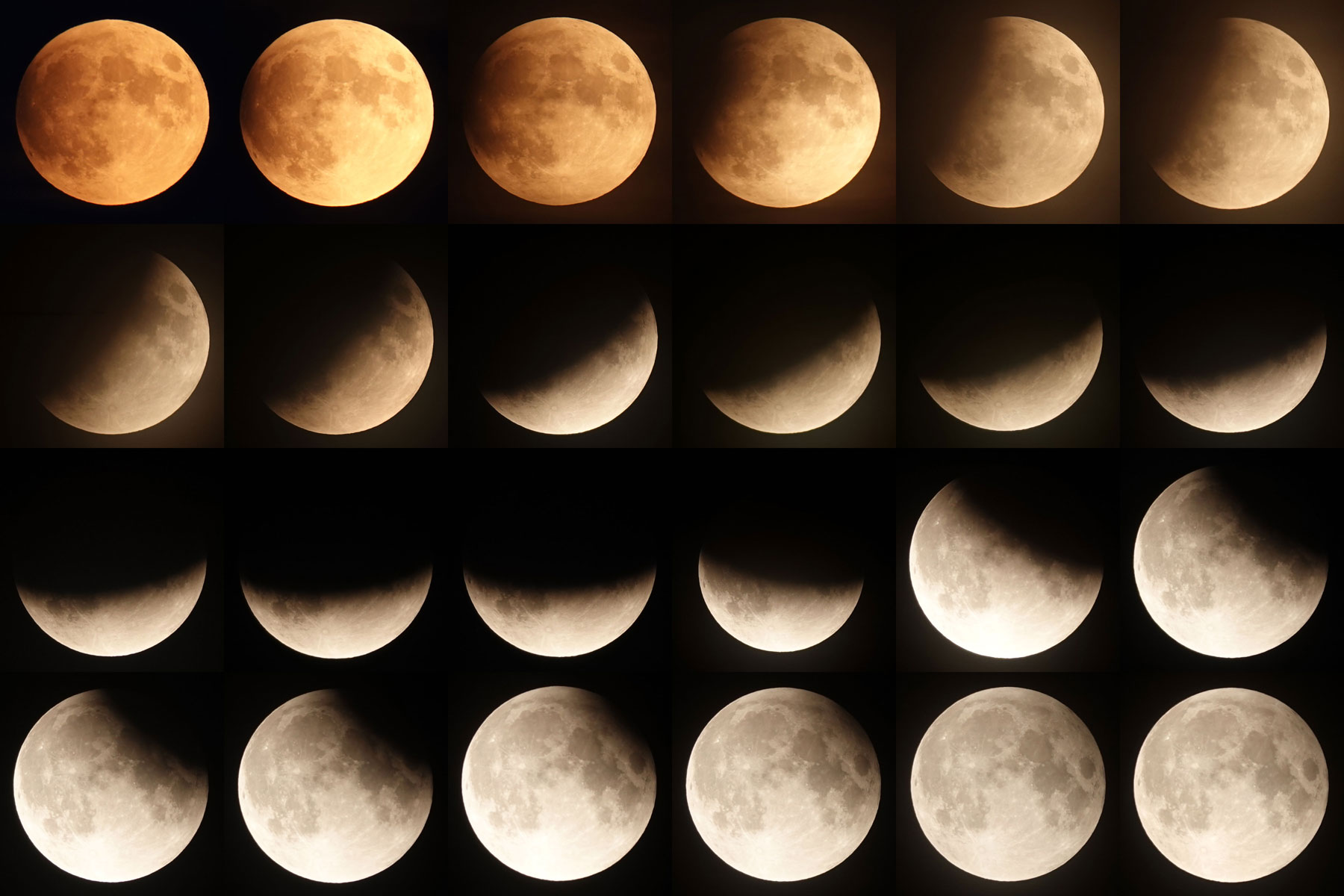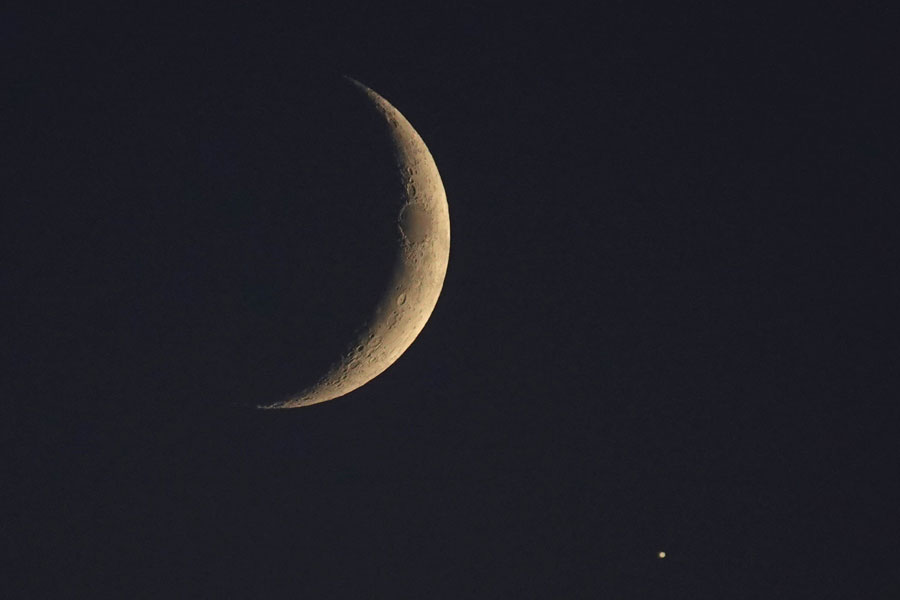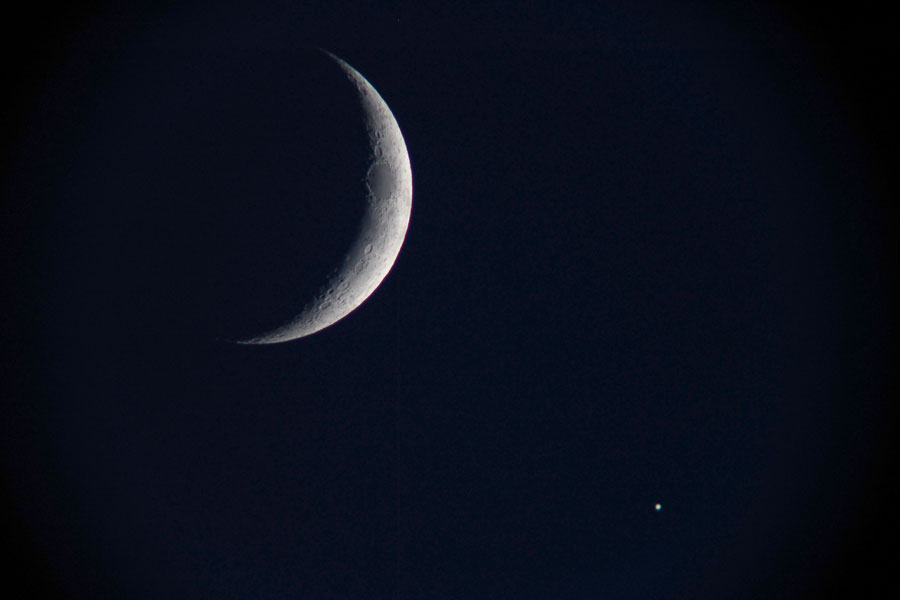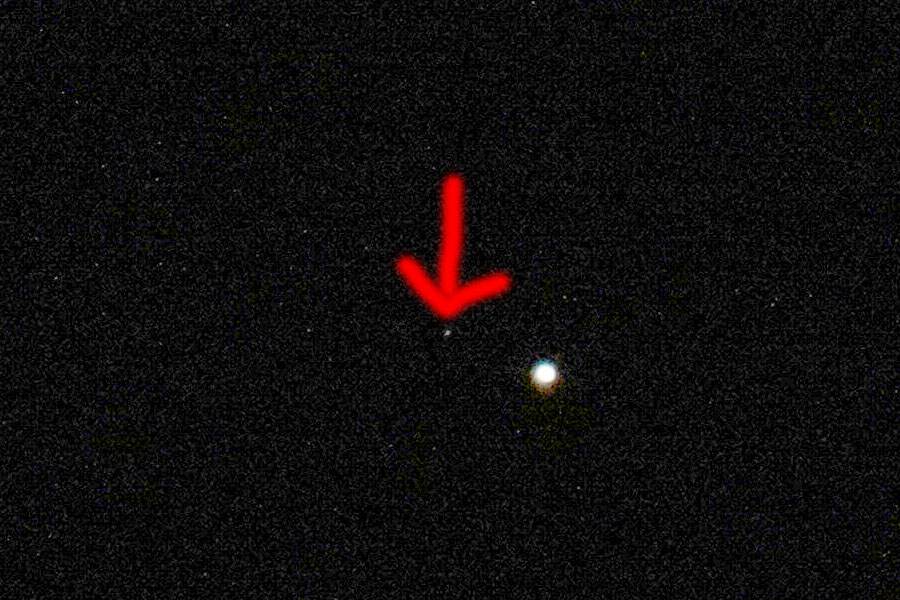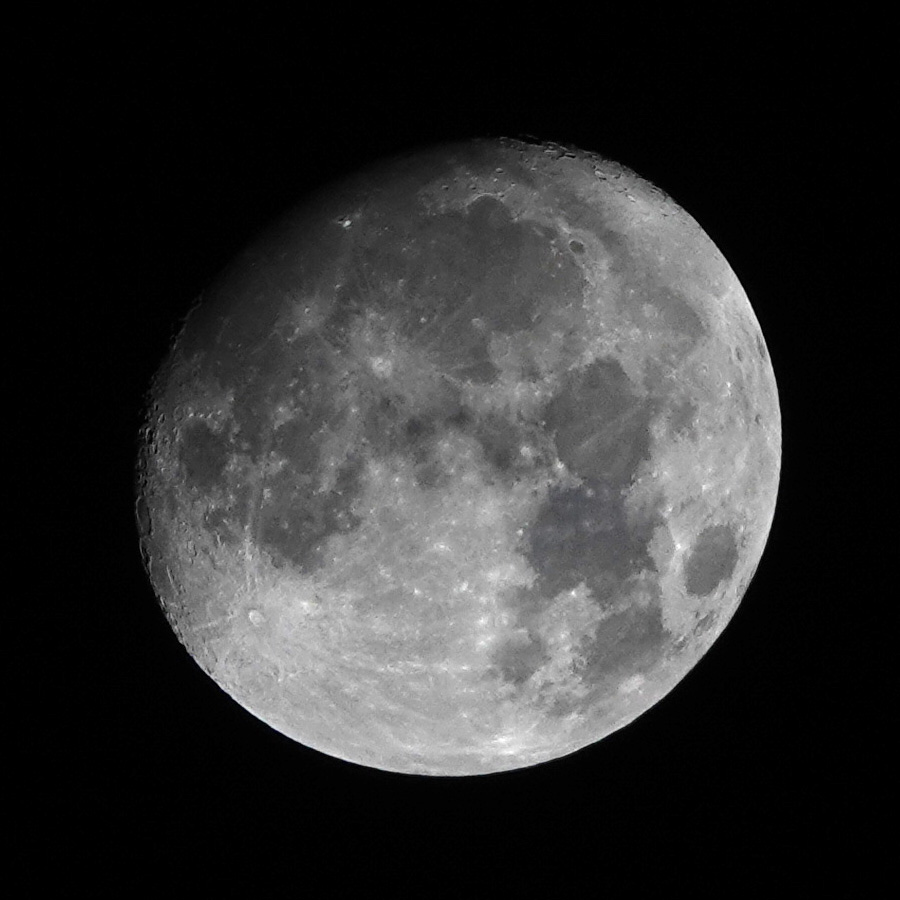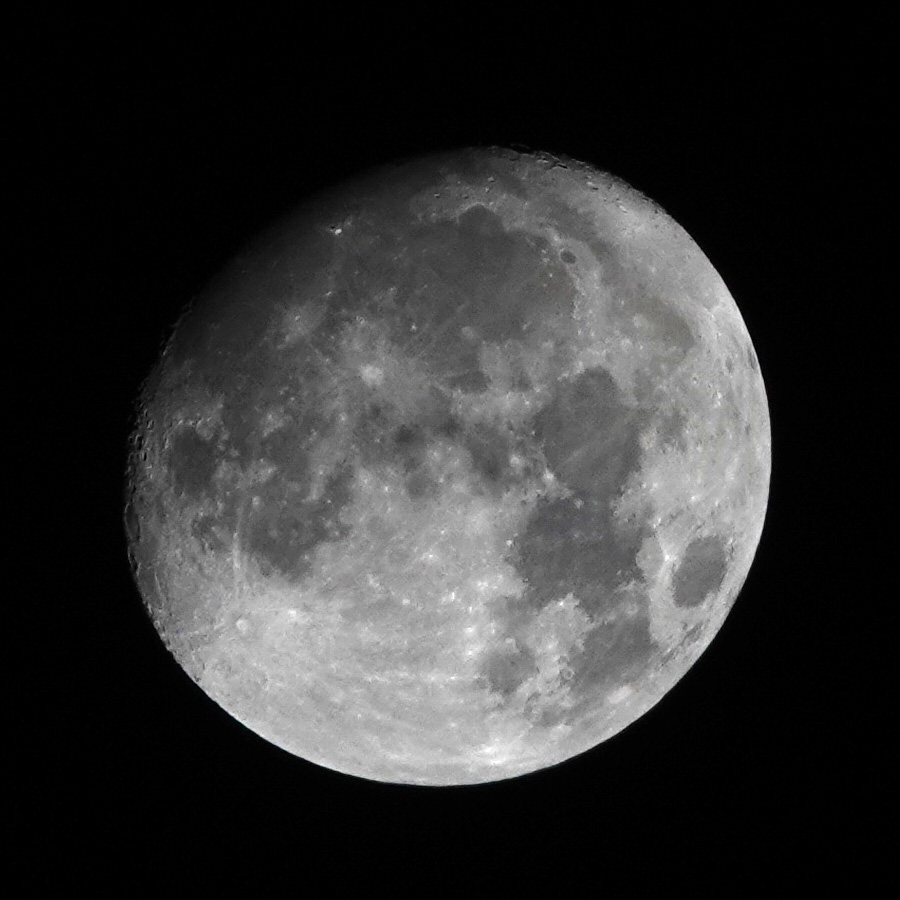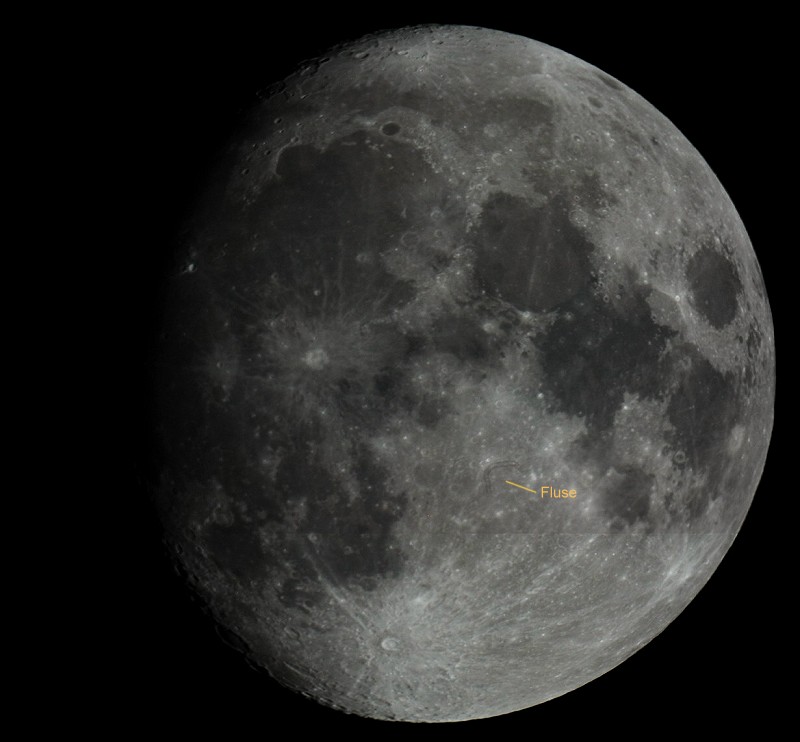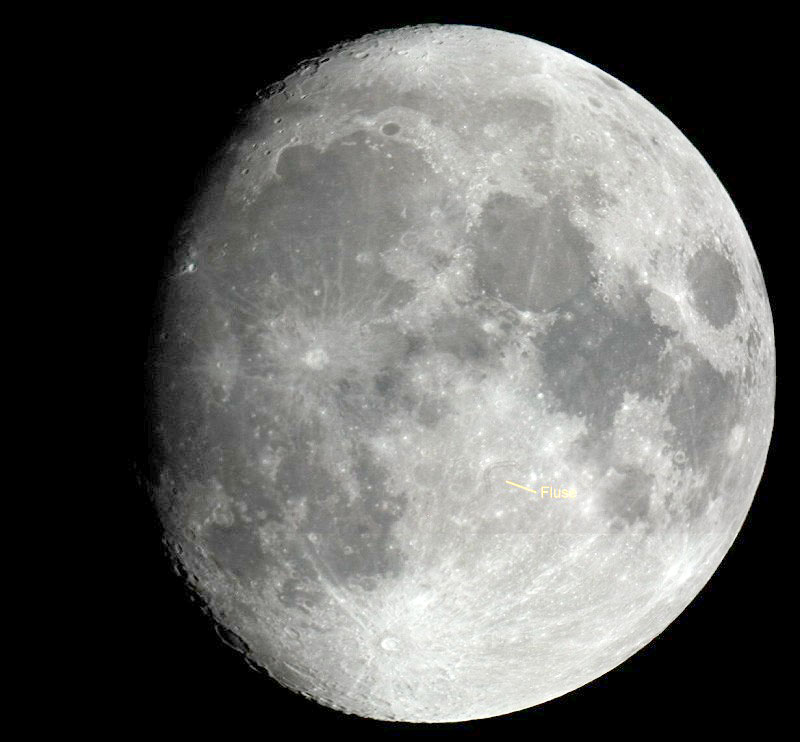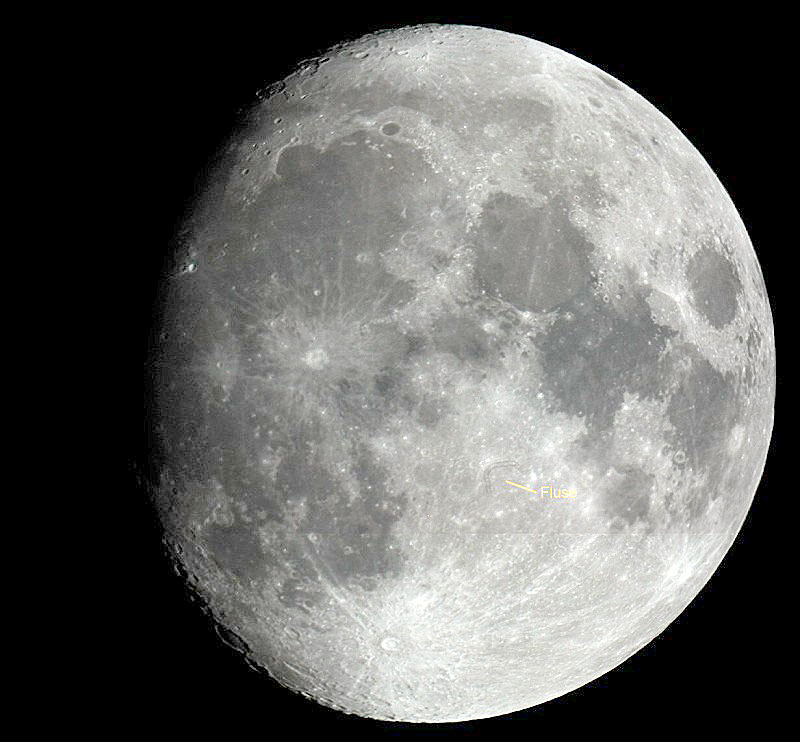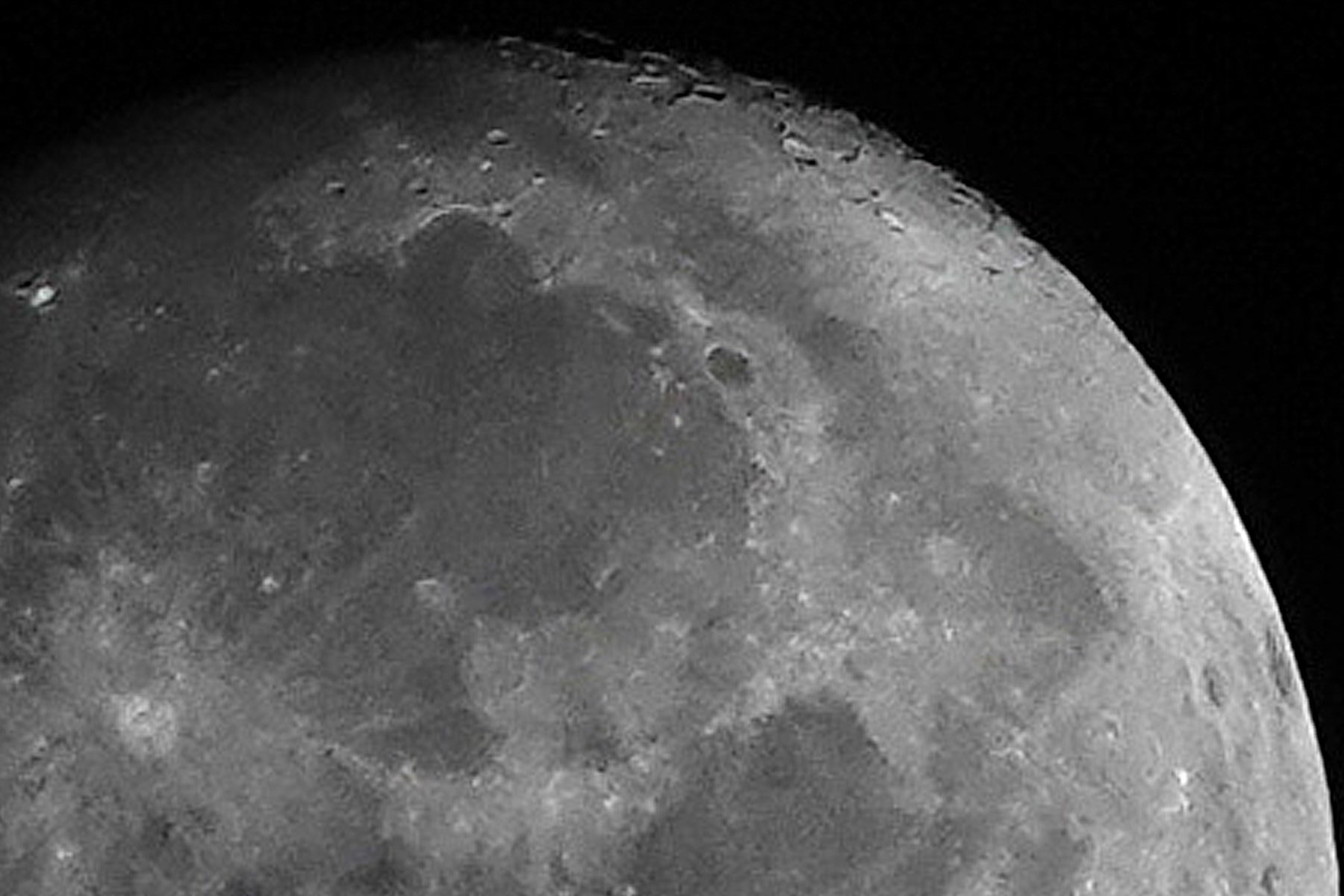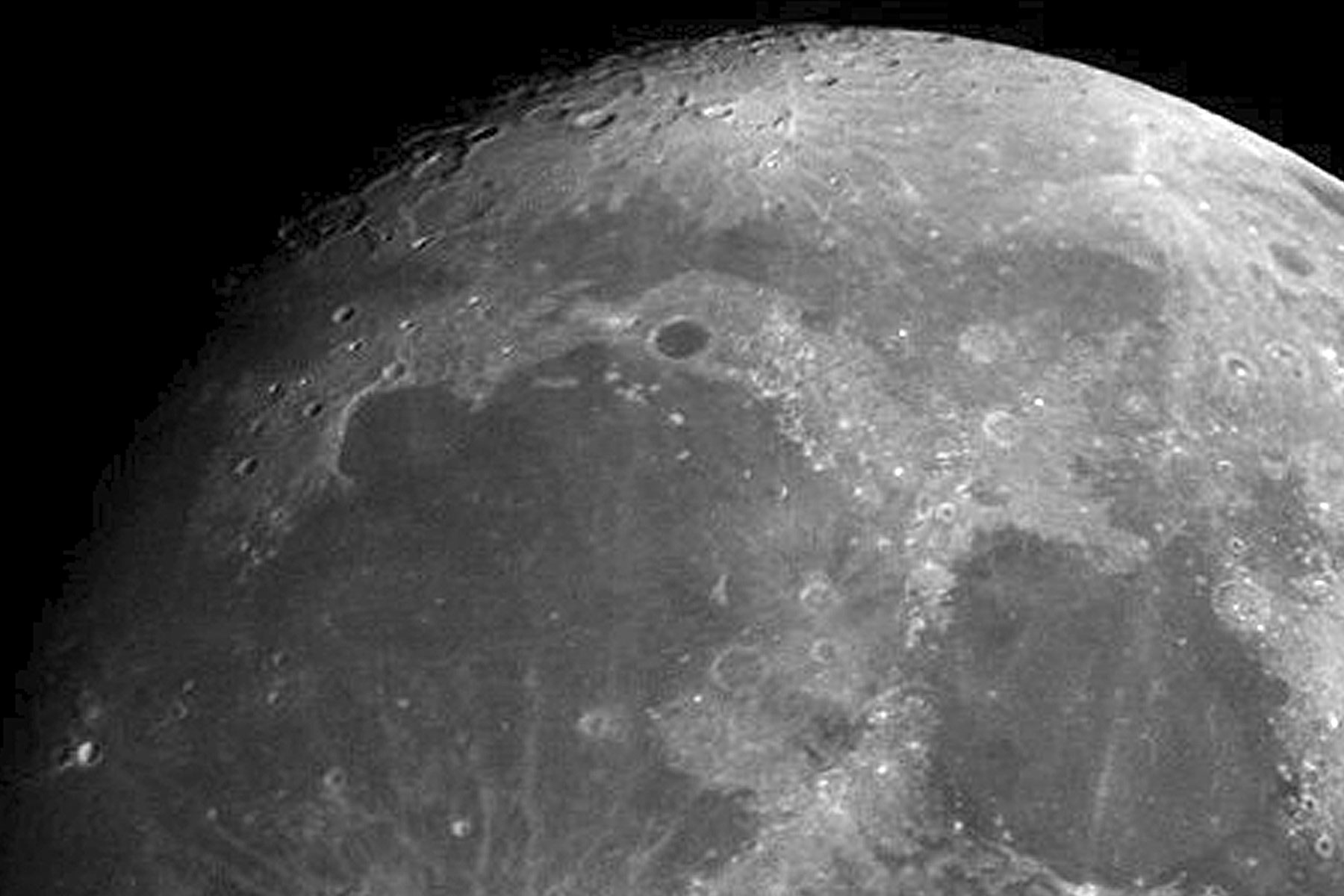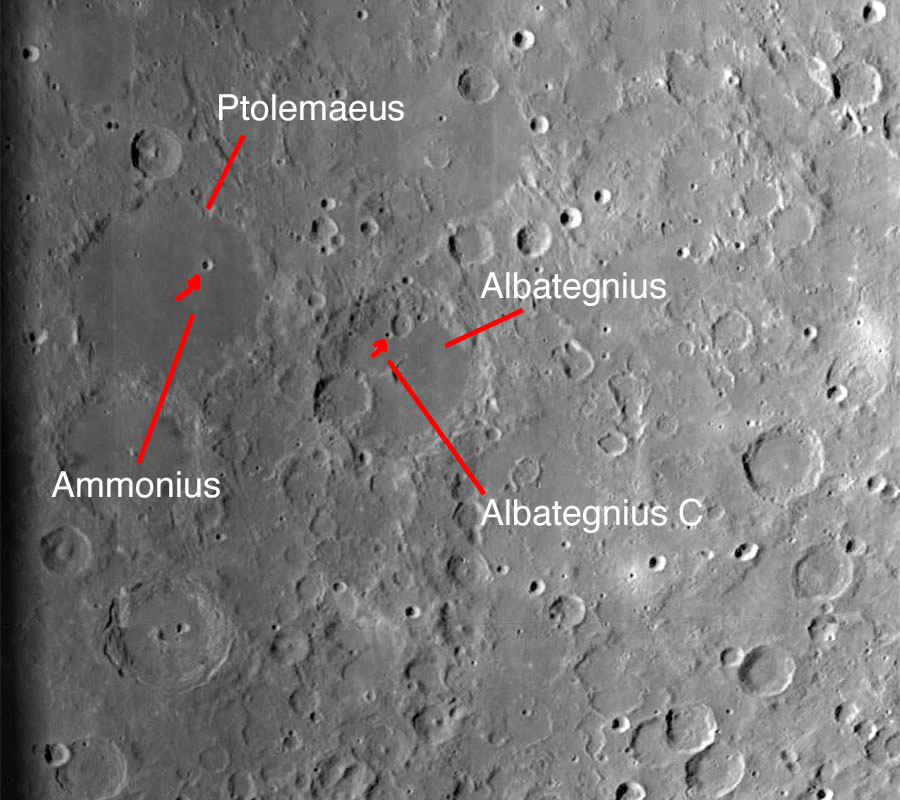Observations of the Sun, the Moon, and Planets 2019
Observation Overview | Special Events | References
It was not until 2018 that I began to observe the moon a little more in detail and to document my "more important" observations. On this page, I collect, somewhat unsystematically, my observations of the moon, the sun, and the planets from 2019, which might be of interest to other beginners and are therefore described here.
Note: Older observations are listed on the "Astronomy" overview page. The same applies to deep sky and comet observations.
Observation Overview
| Date 2019 |
Objects Observed | Location | Devices Used | Eyepieces and Cameras Used | Remarks | Further Remarks |
| Jan 14 | Moon | MH | Sony RX10 M3, Panasonic TZ202 | Sony RX10 M3, Panasonic TZ202 | Half moon
|
Tested the Sony RX10 M3 at the moon and compared it with the Panasonic TZ202 |
| Jan 21 | Moon | MH | Skymax-127 on AZ Pronto mount, cable release | 32 mm; Sony RX100 M4 | Total eclipse of the moon, photographed with the Sony RX100 M4 attached to the 32 mm Digiscope eyepiece | Total eclipse of the moon (blood moon), in the morning between 6 and 7 a.m. when it was bitterly cold - photographed from our balcony... |
| Feb 13-19 | Moon | MH | Sony RX10 M3, mostly on a tripod, mostly with cable release | Sony RX10 M3 | I took photos daily from 1 day after half moon until full moon. | I observed daily how the waxing moon changed. |
| Feb 19 | Moon | MH | Sony RX10 M3 | Sony RX10 M3 | I took free-hand photos of the rising full moon during a walk on the Heiligenstein hill. Later, I took photos of the full moon at home (as part of the series above) | The largest full moon of the year 2019 |
| May 12-17 | Moon | MH/Erkerode | PS 72/432 on AZ Pronto mount; Skymax-127 ditto (May 12 only) | 10 mm; 32 mm (SM-127); Sony RX100 M4 | No observations on May 16; observed in Erkerode on May 17 | May 12: Observed: Vallis Alpes and Rupes Recta; of course, also found
on the photos May 13: ditto and Rupes Altai May 14: Golden Handle (Montes Jura) May 15: Diverse structures with text hints for my brother Dieter May 17: Moon photos 1 day before full moon, only one photo really sharp... |
| Jun 7 | Jupiter and 4 moons, M 3 | Sumène (F) | PS 72/432 on AZ Pronto mount | forgot eyepiece data... | Together with madame Girard and her son Dominique, we observed Jupiter and 4 moons | Afterwards, I accidentally found a globular star cluster close to Arcturus; probably, it was M 3 (I confirmed this more or less with books from Stoyan). |
| Jul 8-10 | Moon | MH | Sony RX10 M4; Skymax-127 on AZ Pronto mount | Sony RX10 M4; Sony RX100 M4 | Hand-held photos of the moon with Sony RX10 M4 for testing multiframe methods (hand-held at dusk, MFNR, HDR, normal). | Jul 8: initially clouds; later, the moon was free of clouds |
| Jul 13-14 | Moon | MH | Sony RX10 M4 | Sony RX10 M4 | Photos of the moon with Sony RX10 M4 (1) for another comparison of MFNR with normal (at first also taken hand-held, then with tripod and cable release), (2) for another comparison of HDR with normal. | 13.7.: Photos of the moon taken with RX10 M4 for another comparison
of MFNR with normal Photos and information: MFNR, HDR |
| Jul 15 | Jupiter, Saturn, Moon | MH | Skymax-127 on AZ Pronto mount | various eyepieces, moon with 24 and 32 mm | Observed Jupiter and Saturn with SM-127: 4 moons in an interesting configuration; saw the ring of Saturn well, but not the Cassini division. | Observed the nearly full moon briefly (with a polar filter) |
| Jul 16 | Moon (partial eclipse) | MH | Skymax-127 on AZ Pronto mount; Sony RX10 M4 on tripod |
Sony RX10 M4; Sony RX100 M4 attached to 32 mm eyepiece | Observed the partial eclipse of the moon. Took photos with (1) Skymax-127, 32 mm eyepiece, and Sony RX100 M4 screwed to the eyepiece, cable release, (2) Sony RX10 M4 on tripod. |
We were on the Heiligenstein hill from about 9:30 p.m. on, observed
and took photos from 10:00 p.m. on. |
| July 29 | Jupiter, Saturn | MH | PS 72/432 on AZ Pronto mount | various eyepieces (a.o. 4 mm) | Jupiter with 4 moons: one was far to the left, another one close to
J. on the right, two more at larger distances (mirrored!);
later, the close moon was hidden! Saturn with ring (max. 108 x = 4 mm eyepiece) |
M 51 searched for, but not found... |
| Aug 23 | Jupiter, Saturn | MH | Skymax-127 on AZ Pronto mount | various eyepieces (a.o. 7 mm) | Jupiter with 4 moons: two on the left,two on the right. Saturn with ring (max. 214 x = 7 mm eyepiece) |
Jupiter: stripes well to see. |
| Aug 24 | Jupiter, Saturn | MH | PS 72/432 on AZ Pronto mount | various eyepieces (35, 16, 10 mm) | Jupiter with 4 moons: one on the left, three to the right, two one
above the other. Saturn with ring (max. 43 x = 10 mm eyepiece) |
Jupiter: ; stripes not seen as well as the day before. |
| Aug 25 | Jupiter, Saturn | MH | Explorer 150PDS on Star Discovery mount | various eyepieces (prob. 35, 16, 10, 7, 4 mm) | Jupiter with 4 moons: all on the left, two one
above the other. Saturn with ring nice to see (100 x and more) |
Jupiter: stripes not seen as well as two days before. |
| Aug 26 | Jupiter, Saturn | MH | Explorer 150PDS on Star Discovery mount with StarSense, Skymax-127 on AZ Pronto mount | various eyepieces (prob. 35, 16, 10, 7, 4 mm) | Jupiter with 3 moons. Saturn with ring nice to see |
Jupiter: stripes not seen as well as three days before. |
| Sep 3 | Jupiter, Saturn | MH | PS 72/432 on AZ Pronto mount | 10 mm, 4 mm eyepieces, Amici prism | Jupiter with 4 moons (3 to the left, on to the right, Saturn with PS
72/432, 10 mm and shorter, Amici prism Moon (about 4th day) with PS 72/432, 10 mm, Amici prism |
Moon observed with Amici prism, that it, oriented correctly |
| Sep 4 | Moon, Jupiter, Saturn | MH | PS 72/432 on AZ Pronto mount, Skymax-127 on AZ Pronto mount | diverse eyepieces, prob. up to 4 mm, Amici prism | Jupiter with 4 moons and Saturn with PS 72/432, 10 mm eyepiece and
shorter (4 and 7 mm at Saturn), Amici prism, as well as both with Skymax-127
up to 4 mm (Saturn) and Amici prism |
In the refractor, everything looked much more brilliant, but also outshined, especially the planets. The view in the Maksutov looked "dull" against this. Its advantage was, however, that everything was not that bright; therefore, the Jupiter stripes were much better to see. I was even able to observe Jupiter with a 4 mm eyepiece (375 x) with a quite usable view; in the refractor the view was much more fuzzy. |
| Sep 6 | Moon, Jupiter, Saturn | MH | StarTravel 120/600 on AZ Pronto mount, PS 72/432 on photo tripod | diverse eyepieces | Half moon Jupiter, Saturn: seen well in both refractors Saturn observed with the ST120 at magnifications of up to 150 x (4 mm eyepiece) |
Half moon: Clearly visible color fringes at the edges of the moon
in both refractors, but much stronger in the ST120;
clearly visible air turbulence, much stronger in the ST120. |
| Sep 9 | Moon, Jupiter, Saturn | MH | StarTravel 120/600 on AZ Pronto mount | diverse eyepieces, prob. up to 4 mm; Sony RX100 M4 | Moon: Golden Handle observed and also photographed. Jupiter: observed and also photographed (150 x); Saturn: only observed... |
Moon: Due to color fringing, the Golden Handle appeared yellow (or "golden"), even on my photos |
| Sep 10 | Moon, Jupiter, Saturn | MH | StarTravel 120/600 on AZ Pronto mount | diverse eyepieces, prob. up to 4 mm; 4 mm also with 2 x focal extender | Moon: Golden Handle already further away from the Terminator. Jupiter: Up to 150 x, 4 moons, three of them to the right (in the telescope) Saturn: Up to 300 x (4 mm eyepiece + 2 x focal extender) |
Moon: Crater Gassendi and Mare Humorum good to see |
| Oct 31 | Moon, Jupiter, Ganymed | Erkerode | Skymax-127 on AZ Pronto mount | 32 mm eyepiece, Sony RX10 M4 | Crescent of the moon and Jupiter close together (about 1°) | Mond-Jupiter-Konjunktion; Jupiter-Mond Ganymed im Teleskop zu sehen, auf den Fotos nur bei kräftiger Aufhellung. |
| Nov 9 | Moon | Erkerode | Sony RX10 M4 | Moon close to full | ||
| Nov 11 | Mercury transit of the sun | Mühlhausen | Skymax-127 on AZ Pronto mount | 32 mm eyepiece | Meryury transit of the sun not visible becaise the sky was overcast | Mercury transit 2019 |
| Nov 30, Dec 2, Dec 4 | Moon | Erkerode | C8 on Star Discovery mount (manually) | Various eyepieces (eyepiece comparison) | Eyepiece comparions using the crescent and half moon (Dec 4 = half moon) | Observed two small craters visually on Dec 4: (1) Ammonius in crater Ptolemaeus - 9 x 8 km, (2) Albategnius C in crater Albategnius - 6 x 6 km |
All observations done in Mühlhausen/Kraichgau (MH), except for where noted otherwise.
Special Events
January 21, 2019: Total Eclipse of the Moon (Blood Moon)
On January 21, 2019, another total eclipse of the moon could be observed. We observed and photographed the lunar eclipse from our balcony at home using the Sky-Watcher Skymax-127 and a Sony RX100 M4 attached to the 32 mm eyepiece.
I created a collage from selected photos:
Total Eclipse of the Moon, January 21, 2019
More information on page Total Eclipse of the Moon 2019 (Blood Moon)
February 13-19, 2019 (and January 14, 2019): From Half Moon to Full Moon (Sony RX10 M3)
When comparing the days, you should primarily track and compare the structures at the terminator (shadow boundary).
More information on page Photos of the Moon with RX10 M3 - Mid-February 2019
February 19, 2019: The Largest Full Moon of the Year 2019 (Sony RX10 M3)
The following collage was made from photos of the rising full moon that were taken free-hand with a focal length of 600 mm (equivalent).
The following photos were taken on a tripod with manual exposure and with a focal length of 600 mm (equivalent).
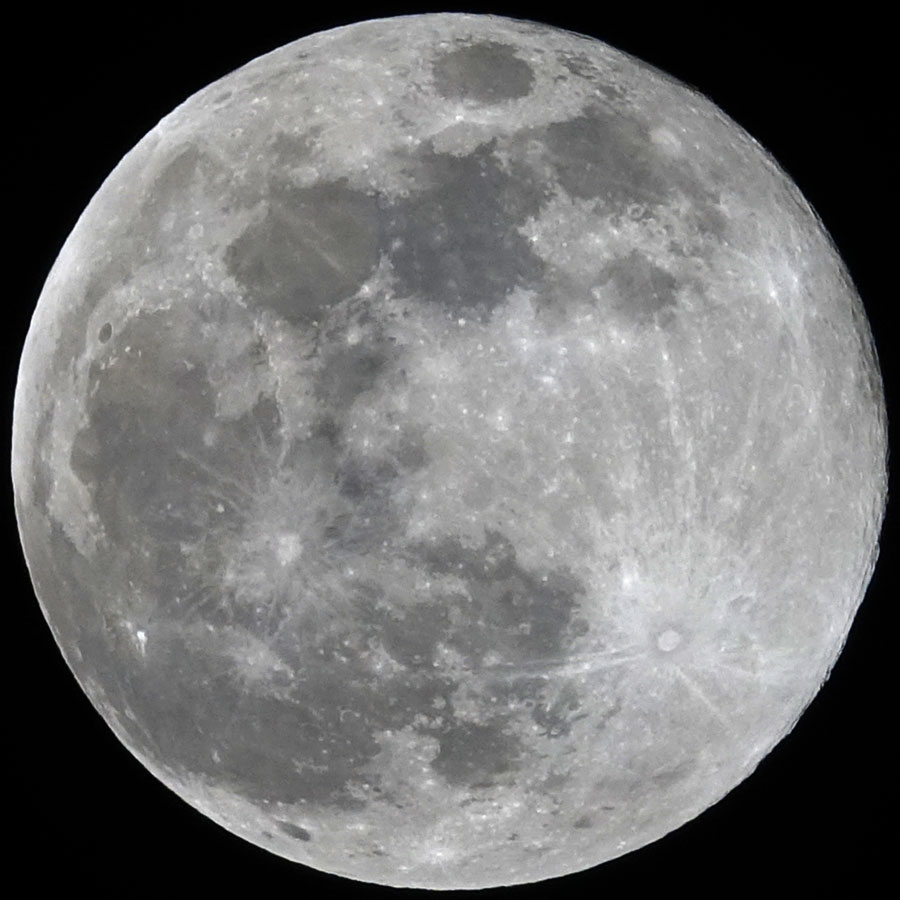 |
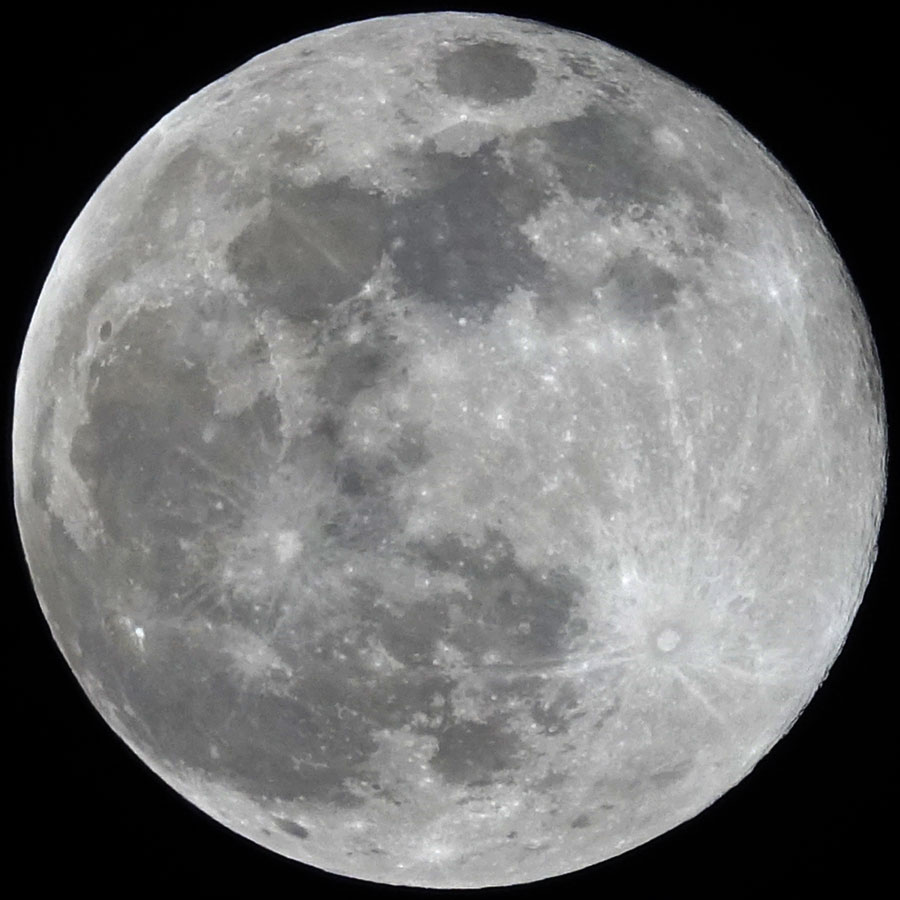 |
|
600 mm, ISO 100, 1/500 sec, f/5.6, tripod, cable release |
600 mm, ISO 100, 1/1000 sec, f/4, tripod, cable release |
More information on page Photos of the Full Moon with RX10 M3 - February 19, 2019
May 12-17, 2019 (except for May 16, 2019): From Half Moon to Nearly Full Moon
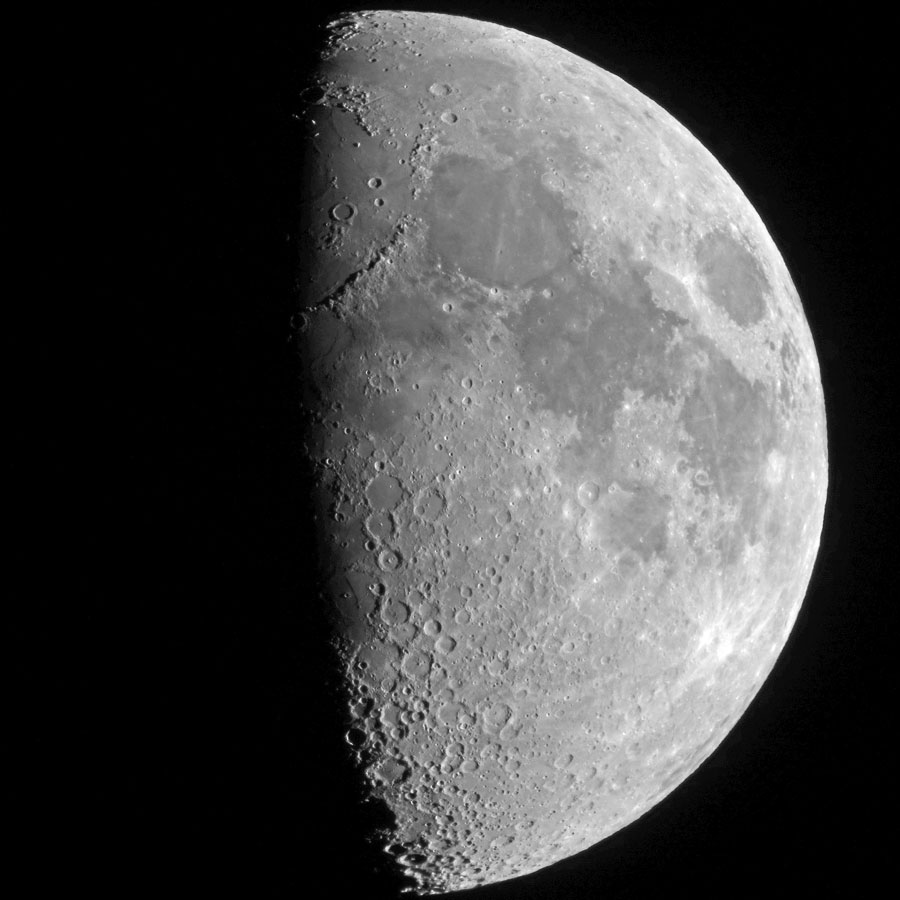 |
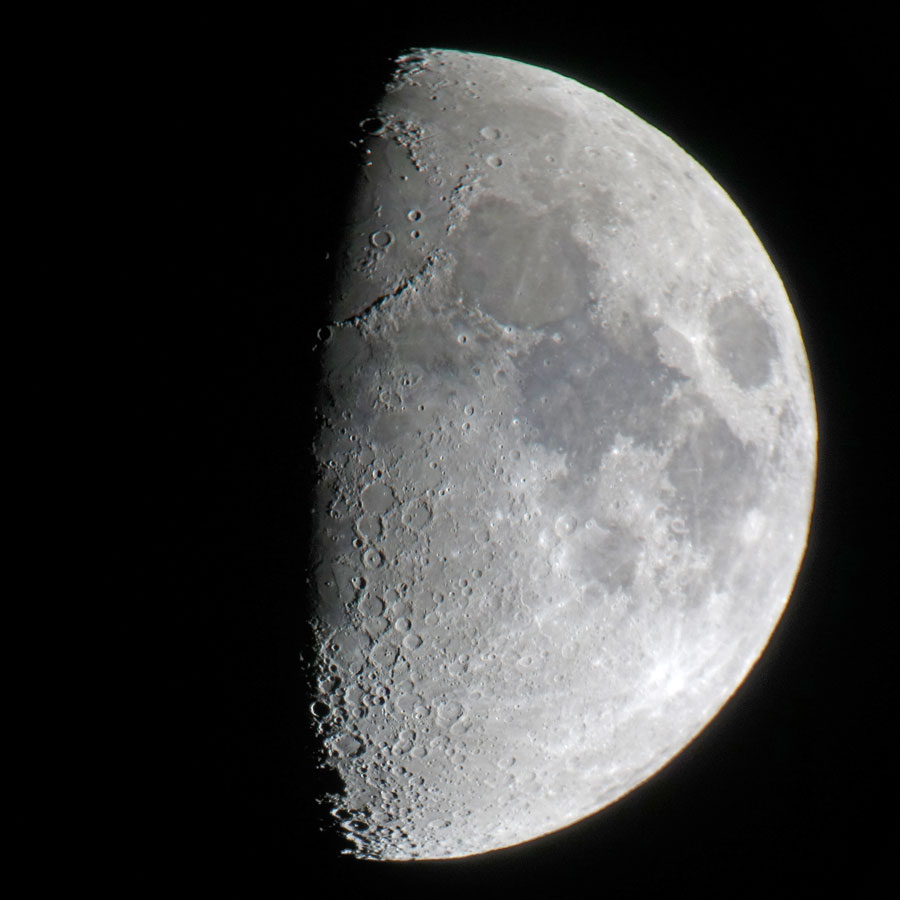 |
|
May 12, 2019: PS 72/432, ISO 125, 1/125 sec, f/2.8, 50 mm; 3200 pixels |
May 12, 2019: Skymax-127, ISO 125, 1/100 sec, f/2.8, 35 mm; 3000 pixels |
|
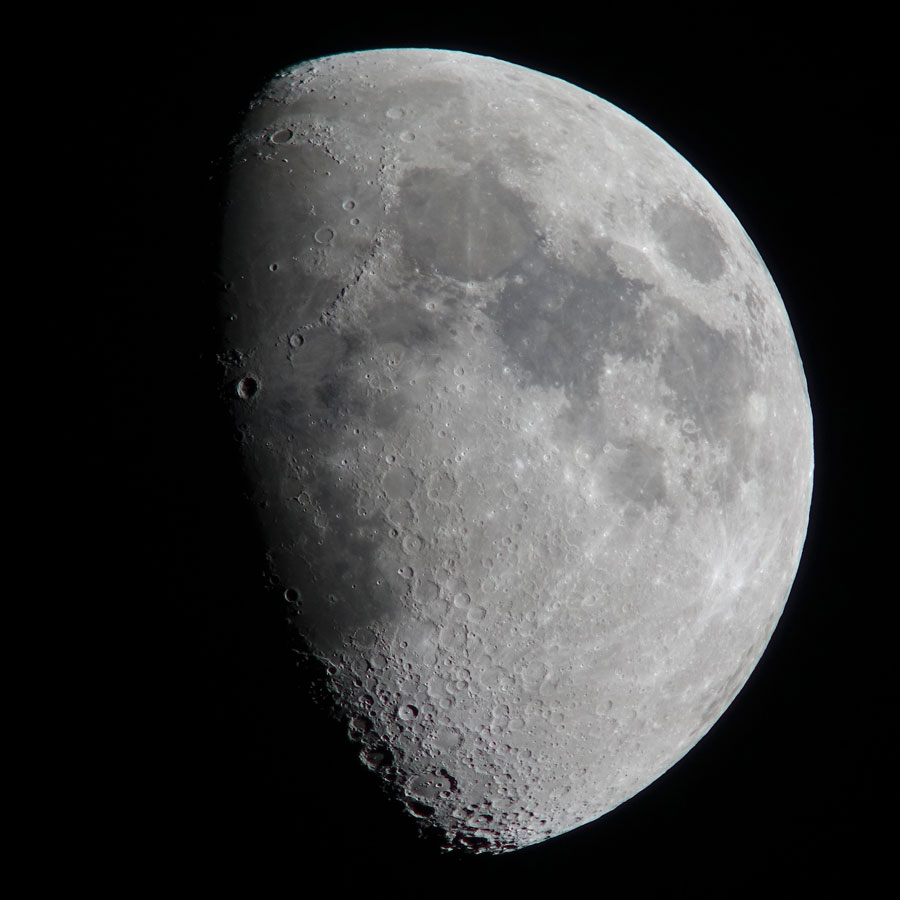 |
 |
|
May 13, 2019: PS 72/432, ISO 125, 1/100 sec, f/2.8, 35 mm; 2500 pixels |
May 14, 2019: PS 72/432, ISO 125, 1/250 sec, f/2.8, 50 mm; 3200 pixels |
|
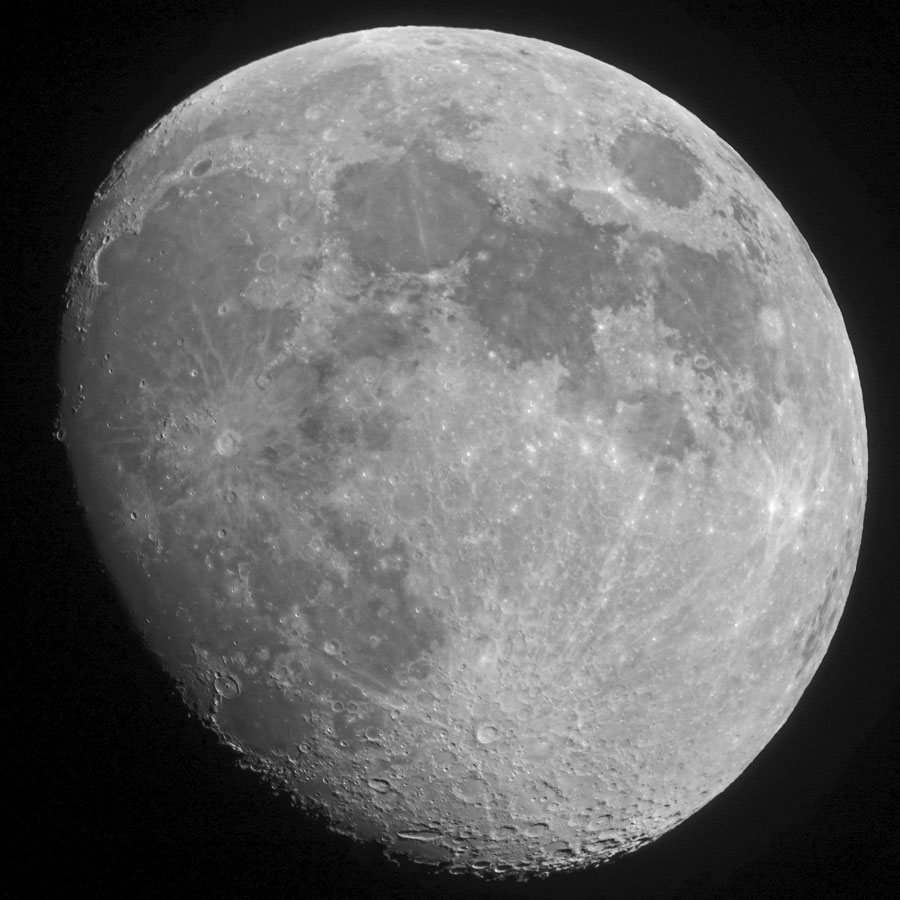 |
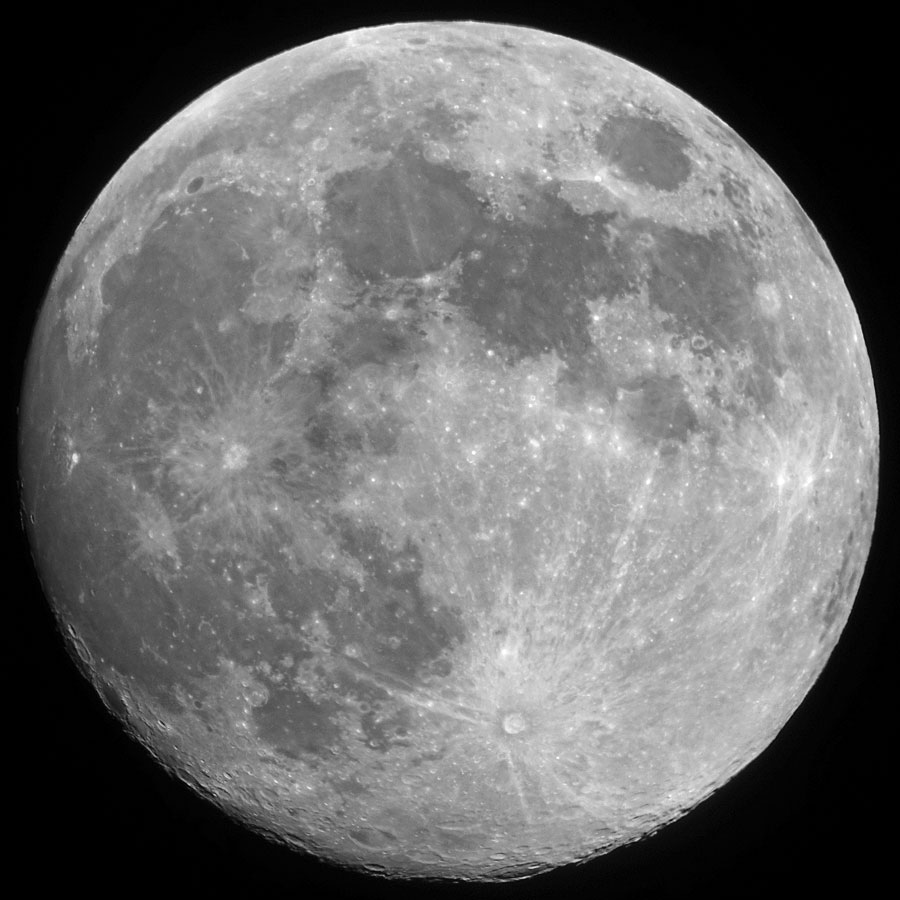 |
|
May 15, 2019: PS 72/432, ISO 125, 1/100 sec, f/2.8, 50 mm; 3200 pixels |
May 17, 2019: PS 72/432, ISO 125, 1/100 sec, f/2.8, 50 mm; 3200 pixels |
July 8-14, 2019: Tests on Multi-frame Methods with the Sony RX10 M4
- See page Test Photos of the Moon with RX10 M4 - July 2019 for information on Multi-frame methods and first results.
- See also page Test Photos of the Moon with RX10 M4 Part 2 - July 2019, which offers more information on Multi Frame Noise Reduction (MFNR).
- See also page Test Photos of the Moon with RX10 M4 Part 3 - July 2019, which offers more information on HDR.
All in all and regrettably, the multi-frame methods did not show any advantages in my tests when compared with normal photos...
July 16, 2019: Partial Eclipse of the Moon
On July 16, 2019, a partial eclipse of the moon could be observed in Germany. We observed and photographed the lunar eclipse on the Heiligenstein hill (from 10 p.m. until midnight) and from our terrace at home (from 0:30 until 1:30 a.m.) using the Sky-Watcher Skymax-127 and a Sony RX100 M4 attached to the 32 mm eyepiece and with a cable release, as well as a Sony RX10 M4 on a tripod.
I created collages from selected photos (the large "jump" results from our returning home from the Heiligenstein hill):
Partial Eclipse of the Moon, July 16-17, 2019 (Sky-Watcher SM-127 and Sony RX100 M4)
Partial Eclipse of the Moon, July 16, 2019, simplified version (Sony RX10 M4)
For more information see pages: Partial Eclipse 2019 (SM-127), Partial Eclipse 2019 (RX10 M4)
September 9, 2019: "Golden" Handle and Jupiter Photos with StarTravel 120/600
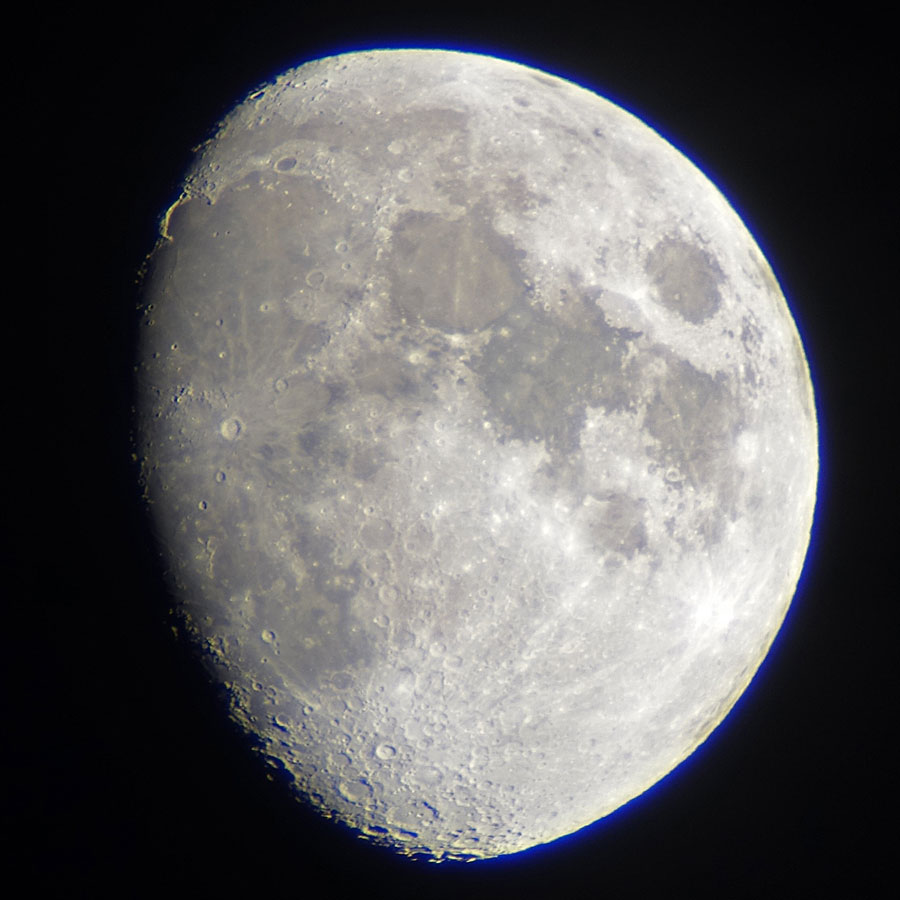 |
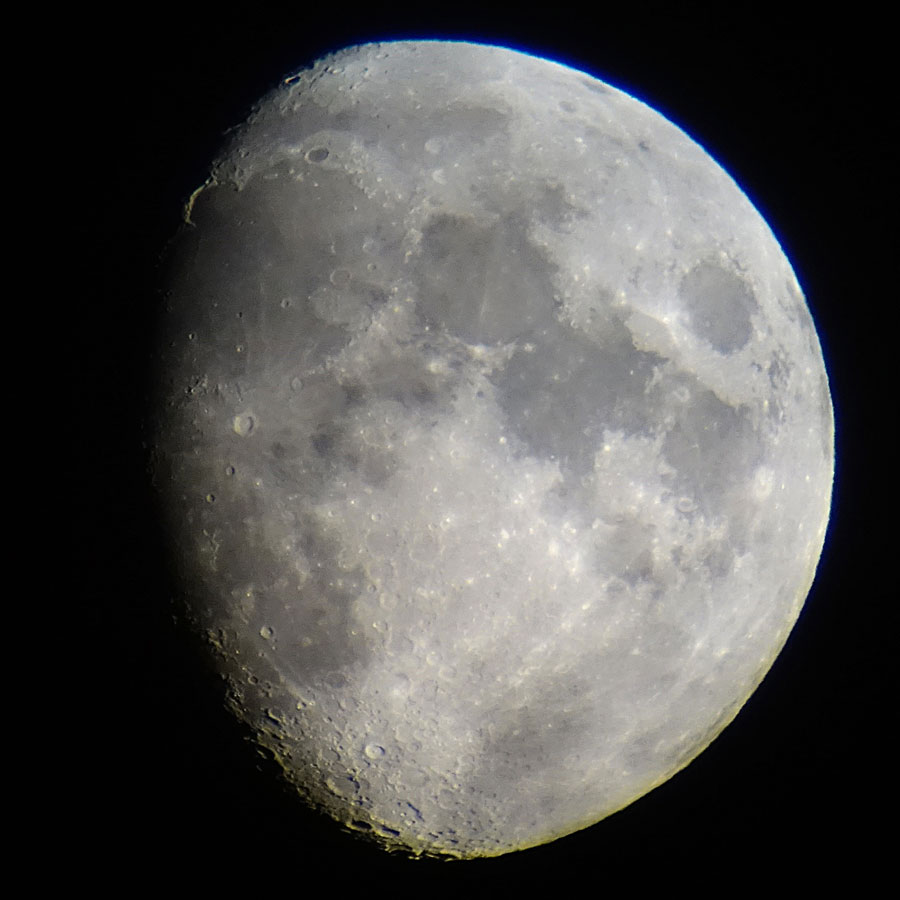 |
Figures: Two samples (sharpened) taken on September 9, 2019; on the photo to the right, the "gold" wandered more to the bottom of the moon... (color fringes)
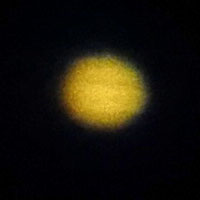 |
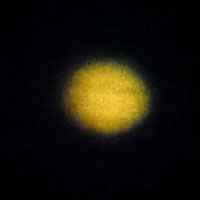 |
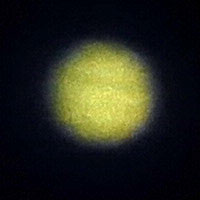 |
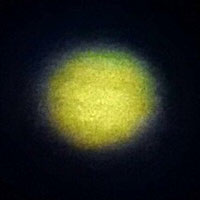 |
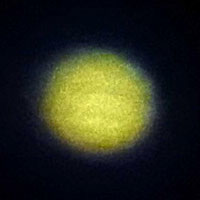 |
Figures: Jupiter with ST120 and 10 mm eyepiece, Sony RX100 M4 held to the eyepiece; the two photos on the left were taken with 50 mm focal length (equivalent), the three right photos with 70 mm focal length (equivalent).
For more information see page: Sky-Watcher StarTravel 120/600 OTA Information (4.7" Refractor, Borrowed)
October 31, 2019: Photos of the Conjunction of Moon and Jupiter (Sony RX10 M4)
For more information see page: Moon and Jupiter - End of October 2019 (Conjunction)
November 9, 2019: Moon Photos (Sony RX10 M4 and Nikon D40)
Only two of the many moon photos that I took with the Sony RX10 M4 (freehand) on that day in Erkerode were really sharp. For comparison, I present a photo taken by my star friend with a Nikon D40 (APS-C) in the Stuttgart area on the same day. If you look at his and my photos at a higher magnification, you can see that the RX10 M4 with its 1" sensor "smears" compared to a camera with an APS-C sensor.
In the following, I present two 400% sections to make the differences between the photos more evident:
Figure: The photo taken with the Sony RX10 M4-Foto shows strong JPEG artifacts when overmagnified (400%) and sharpened (these are already visible at 100%) and actually few details. Vallis Alpes to the right (here more below...) of crater Plato is invisible.
Figure: The photo taken with the Nikon D40-Foto exhibits fewer JPEG artifacts when overmagnified (400%) and sharpened and considerably more details. Vallis Alpes to the right of crater Plato is clearly visible as a "dash."
December 4, 2019: Visual Search for Small Moon Craters with the C8
I was able to see the following small moon craters with the Celestron C8: (1) Ammonius in crater Ptolemaeus - 9 x 8 km, (2) Albategnius C in crater Albategnius - 6 x 6 km. Here is a demonstration of this that I created with the Virtual Moon application:
References
Links
- Mond (Wikipedia): de.wikipedia.org/wiki/Mond
- Moon (Wikipedia): en.wikipedia.org/wiki/Moon
- Virtual Moon Atlas: ap-i.net/avl/en/start
Books (in German)
- Lambert Spix (2013, 3. Auflage). moonscout - Mondmeere, Krater und Gebirge einfach finden und beobachten. Oculum-Verlag. ISBN 978-3-938469-58-3
- Lambert Spix & Frank Gasparini (2011, 1. Auflage). Der Moonhopper. Oculum-Verlag. ISBN 978-3-938469-54-5
- Ronald Stoyan, Hans-Georg Purucker (2013, 1. Auflage). Reiseatlas Mond. Oculum-Verlag. ISBN 978-3-938469-64-4
- Robin Scagell (2016). 101 Himmelsobjekte, die man gesehen haben muss, Kosmos
Verlag (out of print)
www.kosmos.de/buecher/ratgeber/astronomie/einsteiger/6527/101-himmelsobjekte-die-man-gesehen-haben-muss
On this Website
- Sky-Watcher Skymax-127 OTA Information (5" Maksutov-Cassegrain)
- Omegon Photography Scope 72/432 ED OTA Information (2.8" Refractor)
- Sky-Watcher StarTravel 120/600 OTA Information (4.7" Refractor, Borrowed)
- Sky-Watcher Explorer 150PDS Information (6" Newton)
- Celestron C8 OTA Information (8" Schmidt-Cassegrain)
- Sky-Watcher AZ Pronto Mount Information
- Sky-Watcher Star Discovery AZ GoTo Mount Information
- My Binoculars
- "Moon Walks"
| 13.02.2025 |
